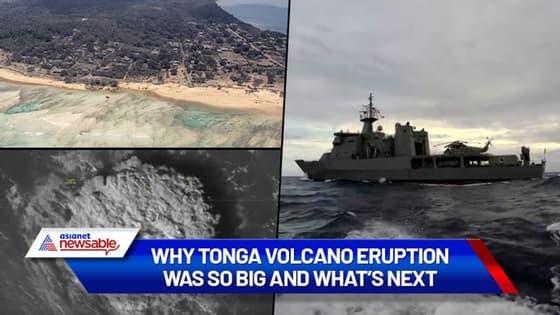
Explained: True magnitude of the Tonga volcano eruption and what may happen next
Authorities on Wednesday confirmed three deaths in Tonga, with concerns remaining over the situation in some of the hard-hit smaller islands.
The world remains in a state of shock after spectacular satellite images of an undersea volcano erupting on the island of Tonga left a giant mushroom cloud in the Pacific region. With shocking visuals continuing to splash social media platforms, several people wonder why the eruption was of such gigantic proportions, how the resulting tsunami travelled so far, and what may happen next.

Authorities on Wednesday confirmed three deaths in Tonga, with concerns remaining over the situation in some of the hard-hit smaller islands. Dozens of homes were also destroyed. New Zealand and other nations continue to get water and other supplies to Tonga as quickly as possible.
Scientist from New Zealand - Volcanology professor at University of Auckland, Shane Cronin, and tsunami expert at the National Institute of Water and Atmospheric Research, Emily Lane, shed light on the situation in an explainer to AP news.
The eruption of the Hunga Tonga Hunga Ha'apai volcano on Saturday was explosive and relatively brief. Reports said the plume rose more than 30 km into the air, but the eruption lasted only 10 minutes. Cronin observed that the eruption's power ranks among the world's most prominent over 30 years. He added that the height of the plume of ash, steam and gas was equivalent to the Philippines' Mount Pinatubo eruption of 1991 that led to the death of several hundred people.
Scientists believe that the magma inside the volcano in Tonga was under enormous pressure and had several gasses trapped within it. They added that a fracture in the rock triggered a sudden pressure drop, resulting in the gas expanding and blasting the magma apart. Explaining the possible reason for the explosion, Cronin said the crater that sits about 200 meters below the sea surface is giant enough for seawater to pour into the volcano and turn it into steam, adding to the energy of the eruption.
The explosion also led to a Pacific-wide tsunami of about 1 meter that destroyed boats in New Zealand and an oil spill in Peru. Expressing surprise over the incident, Emily Lane said that earthquakes rather than a single volcano often triggers oceanwide tsunamis. Lane added that one factor that may have led to the tsunami is an underwater flank of the volcano collapsing and displacing water. Lane noted that the shock wave, or sonic boom, from the volcano, may have pumped more power into the tsunami waves.
Also read: New Zealand to ban cigarettes for next generation in bid to outlaw smoking by 2025
One mystery that looms large is why the tsunami was not more destructive in Tonga, which sits almost on top of the volcano. Calling the question a million-dollar one, Cronin added that the images released so far show the level of devastation is less than what most people feared. Lane noted that increased activity at the volcano a day before the eruption and the loud bang before the tsunami gave the people of Tonga enough time to scramble to higher ground. Lane added that reefs, lagoons, and other natural features could also have protected the island's parts.
Regarding the acidic, but not poisonous, ash that has coated Tonga, Cronin stated that Tongans may still be able to drink from their rainwater supplies even if some ash has fallen. The water is likely to be acidic and salty but not harmful.
Cronin and Lane envision two possible scenarios for the volcano in the future. First, it has exhausted itself for now and is likely to go quiet for the next couple of decades as magma slowly returns. Secondly, a new magma is expected to rise quickly to replace that which exploded, leading to further eruptions. However, they believe the cracks and rifts caused by Saturday's eruption will allow more gas to escape, resulting in explosions of lesser magnitude, at least for now.